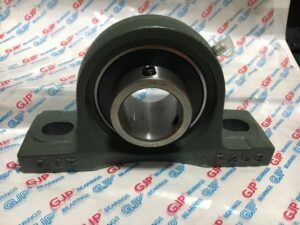First, what are stainless steel flange bearings?
Stainless steel flange bearings are a mechanical part. Flange bearings are used from printers, and fax machines to monitors, and are featured in ultra-small bore miniature bearings daily.
Moreover, the biggest feature of stainless steel flange bearings is that the flange and the bearing are integrated. When there is no connector at one end of the shaft and it needs to be fixed on a plane such as a plate or a wall, the flange bearing shows its advantages.
Second, the advantages of stainless steel flange bearings
The performance characteristics of stainless steel flange bearings are as follows:
- Washing without pressure: I believe everyone knows that many things are easy to rust after washing. Once rusted, the product’s service life will be greatly reduced, but stainless steel flange bearings can be washed confidently, even after washing. The lubricant needs to be refilled.
- Strong corrosion resistance: Due to the characteristics of stainless steel itself, the corrosion resistance of stainless steel flange bearing is also very strong, and can be applied in many environments.
- Can run in liquid: Many bearings cannot be used in liquid, but stainless steel flange bearings can run well in liquid.
- Clean and hygienic: Due to the excellent corrosion resistance of stainless steel flange bearings, they can still be kept in a relatively clean and hygienic state after a long period of use.
- Strong temperature resistance. The temperature resistance of stainless steel flange bearing is very strong. According to the research, it can be used normally in an environment of -60°C~+200°C, so it can be used in complex environments and bad working conditions.

The use of stainless steel flange bearings is also very wide, and it can be seen in all kinds of precision instruments, equipment, electronic machinery, power tools, chemical machinery, vehicles, etc.
Third, stainless steel flange bearings installation precautions:
Although the stainless steel flange bearings have excellent bearing performance, it is a stainless steel precision bearing after all. If the installation operation is improper, it will still affect the normal operation of the rear bearing and shorten the service life of the bearing. So how to install the stainless steel flange bearings correctly?
Precautions for stainless steel flange bearings installation:
- When installing stainless steel flange bearings, keep the surrounding environment clean to avoid dust intrusion. Otherwise, it will affect the machine tool and bearings;
- When installing, it is best to wear gloves to avoid rusting of stainless steel flange bearings due to sweat on your hands;
- The stainless steel flange bearing will be broken and damaged by impact, so be careful to use it;
- Use professional and appropriate tools to install;
- The stainless steel flange bearing has relatively high requirements for precision, and it is recommended to hot-load.
Fourth, the reasons for the failure of stainless steel flange bearings.
The main reasons for the failure of stainless steel flange bearings are defects and overload. When the applied load is greater than the material strength limit, the part fracture is called an overload fracture. The main reason for overload is the sudden failure of the host or improper installation. Defects such as micro-cracks, shrinkage holes, air bubbles, large foreign debris, overheated structures, and local damage to bearing parts will also cause fractures at the defects during shock overload or severe vibration, which is called defect fracture.

It should be pointed out that during the manufacturing process of the bearing, the re-inspection of the raw materials, the quality control of forging and heat treatment, and the control of the processing process can be correctly analyzed by instruments for the existence of the above defects, and the control must be strengthened in the future. But generally speaking, most of the common stainless steel flange bearing fracture failures are overload failures.
Fifth, Lubrication of stainless steel flange bearings
The main purpose of lubricating stainless steel flange bearings is to avoid direct contact between bearing rings, rolling elements, and cages through the formation of an oil film, thereby reducing friction and wear on the bearing contact area. The main functions of lubrication are:
- Reduce friction and wear between bearing rings, rolling elements, and cages.
- Increase the fatigue life of the bearing. The rolling fatigue life of the stainless steel flange bearing depends on the viscosity of the oil between the contact surfaces and the thickness of the oil film formed.
- The use of lubrication can also discharge friction heat and heat from the outside, to avoid overheating the bearing and deterioration of the oil.
- Proper lubrication can prevent foreign substances from entering the bearing to avoid corrosion.
Xiamen Smark Bearing is a professional pillow block flange bearing exporter. We have many years of export experience and are one of the experts in this industry. GJP strives to develop distributors in each market. If you are interested in our products, please contact us. We will provide you with the best service.

